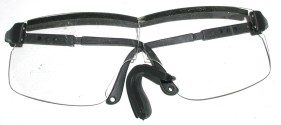 I squeezed the trigger on the CVA HunterBolt 209 Magnum – the muzzle jumped and flashed, and a 275 grain PowerBelt bullet headed for the Chrony’s sky screens, just slightly ahead of a substantial white cloud of gunk. Concurrently, the once distant scope ocular came back and popped me with a Three Stooges’ forehead slap, splitting my safety glasses right down the middle. I couldn’t remember the last time I had as much fun shooting a new rifle.
I squeezed the trigger on the CVA HunterBolt 209 Magnum – the muzzle jumped and flashed, and a 275 grain PowerBelt bullet headed for the Chrony’s sky screens, just slightly ahead of a substantial white cloud of gunk. Concurrently, the once distant scope ocular came back and popped me with a Three Stooges’ forehead slap, splitting my safety glasses right down the middle. I couldn’t remember the last time I had as much fun shooting a new rifle.Odd things…but only for the inexperienced
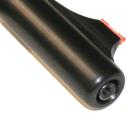
Preparing for initial use of new and unfamiliar firearms can be time consuming, some weird deal will almost always show up that requires mental, if not mechanical, sorting out. The photo to the left illustrates such weirdness; inserting the shorter than barrel length ram rod into the bore, with a patch over the jag, could result in the condition “canotus removus”. Symptoms of this disorder include the shooter’s continual use of the word “damn” and the sound of loud laughter emanating from the surrounding area. As a related work, I can offer “The many faces of a Ram Rod” as depicted below in image form.
 Since there is a threaded hole in end of the rod that is flush with the muzzle when the jag is down in the bore, I figured what was needed was a handle to pull it out, but not just any handle – I ordered a T/C Power Handle, $10 from Cabelas.
Since there is a threaded hole in end of the rod that is flush with the muzzle when the jag is down in the bore, I figured what was needed was a handle to pull it out, but not just any handle – I ordered a T/C Power Handle, $10 from Cabelas.The Power Handle pivots open against a return spring as a T handle, and snaps back to stowed position when released so it will not inadvertently obstruct the muzzle and path of a bullet. Unfortunately, with the handle in place installed in any position, the rod can no longer be stowed with the jag in place, as any attachment greater than the ram rod diameter will not pass through the retaining barrel band and socket recess in the front of the gun’s forearm. Quite the dilemma. In the midst of a storm of hyper brain activity, and a really tasty chili dog, I decided to leave the ram rod as received from CVA, and cleverly reserve use of the Power Handle for the range where the ram rod would be left out on the bench during the shooting session, and it could be used to seat bullets and pull cleaning patches. Then I realized I was spending way to much time on a nothing issue, and needed to get on with my life. The little Power Handle did seem to impress a certain shooting contingency at the range, but clearly none possessing muzzle loader experience.
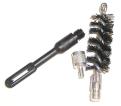
I was finally able to justify the expenditure for my big bore Weatherby, by economizing through the use of its cleaning paraphernalia on the CVA HunterBolt. Instructions packaged with sabot bullets emphasize running a patch through the bore after each firing. PowerBelt bullet information suggests cleaning only when accuracy deteriorates. During my research, I also encountered information that conflicted with both of these guidelines, and some going on to recommend firing an initial squib load so bore fouling will tighten the bullet/bore fit for improved accuracy. Apparently, muzzle loaders can be too clean, as well as too dirty.
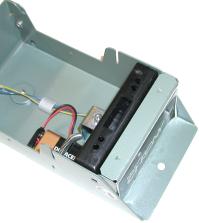 Chronograph manufacturers seem to group muzzle loaders in with paint ball guns, in regard to the need to protect sky screens or sensors from crud that comes out of the muzzle. The first suggestion provided by Chrony is to position the screens 10′ from the muzzle, rather than 5′, to get the box away from the powder residue. A good deal more unburned black powder leaves the bore in comparison to guns utilizing smokeless powder.
Chronograph manufacturers seem to group muzzle loaders in with paint ball guns, in regard to the need to protect sky screens or sensors from crud that comes out of the muzzle. The first suggestion provided by Chrony is to position the screens 10′ from the muzzle, rather than 5′, to get the box away from the powder residue. A good deal more unburned black powder leaves the bore in comparison to guns utilizing smokeless powder.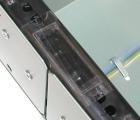 The second muzzle loader suggestion from Chrony was to purchase a guard that would shield the sensor recesses from powder residue. Their concern is that this material could impair the chronograph’s accuracy, and black powder and synthetics draw moisture and are corrosive; neither of which is considered to be electronics friendly. Since I try to be frugal with anything that is none essential (see earlier Weatherby related comments), I decided to make my own sensor protectors. A carton cutter clipped a small “window” from an old part blister pack, and a piece of 2″ packing tape sealed it over the sensor.
The second muzzle loader suggestion from Chrony was to purchase a guard that would shield the sensor recesses from powder residue. Their concern is that this material could impair the chronograph’s accuracy, and black powder and synthetics draw moisture and are corrosive; neither of which is considered to be electronics friendly. Since I try to be frugal with anything that is none essential (see earlier Weatherby related comments), I decided to make my own sensor protectors. A carton cutter clipped a small “window” from an old part blister pack, and a piece of 2″ packing tape sealed it over the sensor.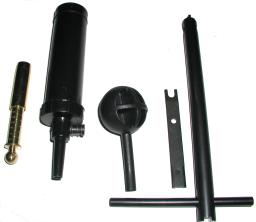
When you bring a muzzle loader out shooting, you need to bring other stuff. Apparently, experienced muzzle loader shooters carry all of their support material around in a “possibles bag”. Personally, I’d rather carry it all in a plastic trash bag than feel like I’m off to see the wizard carrying a buckskin purse. Tossed in the bottom of my shooting box, left to right: a 60~130 grain hunter measure, a 5 oz (2188 grains) flask with a 20 grain spout, a combo short/long bullet starter, a #209 primer capper, and a breech plug/nipple wrench of the painless variety. The flask solves the problem of range rules prohibiting powder being left uncovered, or too large of a quantity of powder at the shooting bench – every range has a set of rules specifically for muzzle loader shooters.
Powder is moved from the retail container to the flask, the flask is used to fill the measure, the measure is used to charge the bore. The use of the small measure, is a step designed to isolate larger quantities of powder from burning embers remaining in the barrel from a prior discharge. The short starter is used for initial placement of the bullet into the bore, the long end drives it far enough for the ram rod to take over. The primer capper installs the #209 primer at the breech and removed it after firing, and the wrench is used when things get screwed up (after following lots of rules) to clear the bore or, more routinely to gain breech end access to clean the bore.
The Shooting experience

With guidelines from CVA and Lyman publications, and information regarding Triple Seven from Hodgdon, I put together a series of loads to use for my first outing. I had Pyrodex in granular and pellet form, and Triple Seven in granular form. As of this writing, Triple Seven pellets are only available in 50 caliber versions.
There is a primary caution with muzzle loading – make sure there is no gap between the charge and the projectile. A mass of burning and rapidly moving powder, slamming into a bullet half an inch away across an air gap, is tantamount to a bullet traveling down a barrel and encountering a solid obstruction; they both result in a huge pressure spike. Instruction from every source, including range muzzle loader safety rules, made so much of this issue I assumed bullet seating was hard work, and easy to do incorrectly. Not so, the process is simple, it is really easy to seat a bullet and tell when it is bottomed.
Velocity initially varied a considerably with developing bore condition; the initially very clean bore produced lower velocity and larger groups. The table below indicates first results, at least an average of first results, net of the very first shots taken. The CVA rifle is designed specifically to handle 150 grains of powder, such as Pyrodex and Pyrodex pellets. Hodgdon suggested a maximum load at 130 grains of Triple Seven in this particular rifle as Triple Seven produces approximately 15% more energy than black powder, or other black powder substitutes, in like quantities.
| Powder | Charge | Bullet | Bullet Weight | Velocity | Energy |
| Pyrodex pellets | 100 grains | Sabot .45/40 | 180 grains | 1860 | 1384 |
| 150 grains | Sabot .45/40 | 180 grains | 2234 | 1995 | |
| Pyrodex RS | 100 grains | Sabot .45/40 | 180 grains | 1848 | 1365 |
| 150 grains | Sabot .45/40 | 180 grains | 2222 | 1974 | |
| Triple Seven | 80 grains | Sabot .45/40 | 180 grains | 1993 | 1588 |
| 100 grains | Sabot .45/40 | 180 grains | 2108 | 1777 | |
| 130 grains | Sabot .45/40 | 180 grains | 2265 | 2051 | |
| Pyrodex pellets | 100 grains | PowerBelt .45 | 275 grains | 1711 | 1788 |
| 150 grains | PowerBelt .45 | 275 grains | 2013 | 2475 | |
| Pyrodex RS | 100 grains | PowerBelt .45 | 275 grains | 1726 | 1820 |
| 150 grains | PowerBelt .45 | 275 grains | 2007 | 2460 | |
| Triple Seven | 80 grains | PowerBelt .45 | 275 grains | 1721 | 1809 |
| 100 grains | PowerBelt .45 | 275 grains | 1905 | 2217 | |
| 130 grains | PowerBelt .45 | 275 grains | 2043 | 2549 |
I was impressed with the results, and quickly came to appreciate the potential of this gun that could launch 275 grain bullets at over 2,000 fps. The HunterBolt rifle handled like a cartridge gun, and the muzzle loading related activities became second nature in a short time. The gun’s synthetic stock has a Remington 700 look and feel, making it a relatively easy gun to put on target. I had zero mechanical problems during the shooting session from either the gun, or the shooting accessories that were part of the kit. The rifle has recoil, even at 100 grains. I had a .25-06 at the bench also and it was a much softer shooting gun from the bench. From a standing position, the recoil was insignificant.
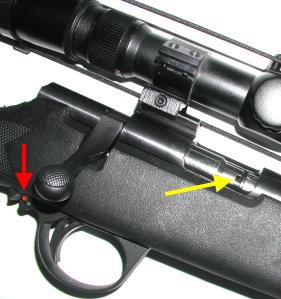
The safety (red) is handy and easy to get at, however, it is a little on the noisy side. But considering I’ve had a deer walk up on me in the distant past, while eating lunch, drinking coffee and reading a comic book, this noise may not be a factor in most situations.
The bolt/breech gap (yellow) is a source of some minor sparks, as in the range firing line official saying, “Hey, there’s some fire coming out of the side of your gun”, but I think that is probably quite normal for any firearm with an exposed primer or percussion cap. In any case, these sparks are not near hands or face and were of zero impact all day. It’s just a little different than a rifle with an enclosed cartridge. I had a lot of people ask about the rifle and make favorable comments. It wasn’t out of place on the firing line with other types of firearms, most people couldn’t believe the low price.
Accuracy and consistency
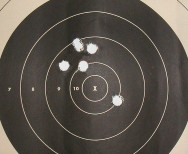 I don’t believe I am qualified to speak to the gun’s accuracy or ability to group, as I am sure I am inconsistent in bullet seating pressure and bore preparation. The 5 shot group at the left, excluding the reduced charge lower flyer, is about 2″. Hey, the HunterBolt out shot my .30-30 Marlin 336. This is typical of the groups I was able to shoot with both bullet weights.
I don’t believe I am qualified to speak to the gun’s accuracy or ability to group, as I am sure I am inconsistent in bullet seating pressure and bore preparation. The 5 shot group at the left, excluding the reduced charge lower flyer, is about 2″. Hey, the HunterBolt out shot my .30-30 Marlin 336. This is typical of the groups I was able to shoot with both bullet weights.Different bullet weights go to different places. In my gun, a change from 275 to 180 grain bullets, maintaining the same powder charge, resulted in a 3″~4″ upward shift in point of impact. A change from 100 grains of powder to 150 grains shifted point of impact upward perhaps 2″~3″. All combinations performed predictably once a norm was established. From a power and accuracy standpoint, I wouldn’t hesitate to hunt with the CVA. However, as a consistently lousy shot, I typically refrain from hunting with single shot rifles, including metallic cartridge type. After I gain a bit of proficiency in loading, or perhaps have some practice with a speed loader, I may rethink this personal policy, as it would be a lot of fun to hunt with this gun.
Cleaning

Muzzle loaders get dirty, inside and out. The #209 primer ignition system is very reliable, but everything near the primer gets a carbon coating, including the bottom side of the scope. Not a functional problem, as primers went on and spent primer came off, with no special effort, using only the little priming tool that came with the rifle kit. Since I clean smokeless firearms after each use, this wasn’t a big deal, but cleaning before stowing is necessary to prevent serious corrosion.
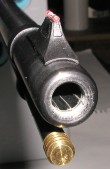
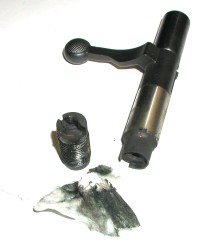 The bore was relatively easy to clean; a couple of passes with a brush and cleaner, maybe three or four patches on a jag. The real gunk was all over the bolt, and bolt side of the breech plug – all primer residue from the open gap between the bolt face and the breech plug. The CVA kit came with a small parts cleaning basket, so I dropped the breech plug and some disassembled bolt parts in, and let them soak while I brushed the rest of the parts off with Citrus cleaner.
The bore was relatively easy to clean; a couple of passes with a brush and cleaner, maybe three or four patches on a jag. The real gunk was all over the bolt, and bolt side of the breech plug – all primer residue from the open gap between the bolt face and the breech plug. The CVA kit came with a small parts cleaning basket, so I dropped the breech plug and some disassembled bolt parts in, and let them soak while I brushed the rest of the parts off with Citrus cleaner.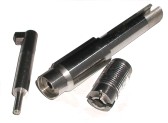 The photo on the right shows an example of how well the gun cleaned up with a minimum of time and effort. The bolt is very easy to disassemble and reassemble; one cap screw in the back of the bolt shroud allows the shroud to be unscrewed and the firing pin and return spring to be removed. There was a superficial etch mark on the bolt face from the primer burn which I will keep an eye on it, and see how it holds up with increased shooting activity.
The photo on the right shows an example of how well the gun cleaned up with a minimum of time and effort. The bolt is very easy to disassemble and reassemble; one cap screw in the back of the bolt shroud allows the shroud to be unscrewed and the firing pin and return spring to be removed. There was a superficial etch mark on the bolt face from the primer burn which I will keep an eye on it, and see how it holds up with increased shooting activity.So what’s the deal?
I really enjoyed shooting and working with this gun, and I’ve gained a lot of respect for muzzle loaders after acquiring this first hand experience. CVA put together a great value in their current Magnum series firearms, and I get the sense mine will hold up for a long time and a lot of use. Hodgdon products burned cleanly and produced good power, I don’t believe I would trade this for traditional black powder, unless some competitive rules required such a change. I’d like to try casting some bullets to see how accuracy is impacted by alloy mix, bullet size and design but, for now, there are many good commercial grade bullets on the market at prices affordable for my level of shooting activity. Great stuff, I’m looking forward to the next muzzle loader shooting opportunity.
More “Click…., and then bang”:
Click…., and then bang
Click…., and then bang Part II
Click…., and then bang Part III – Conclusion
Thanks,
Joe

Email Notification